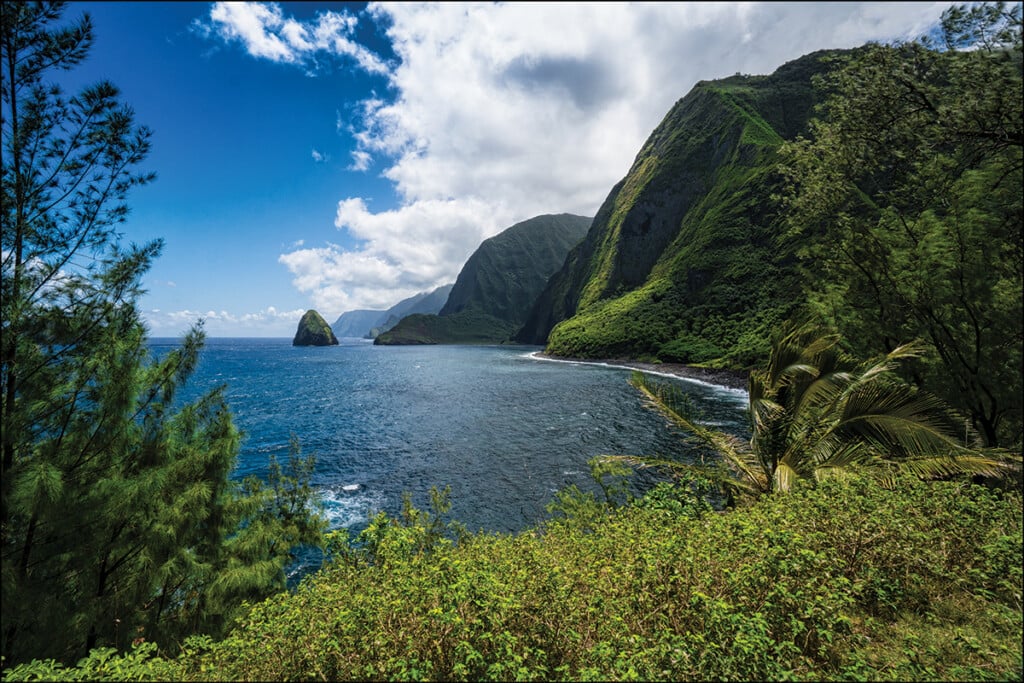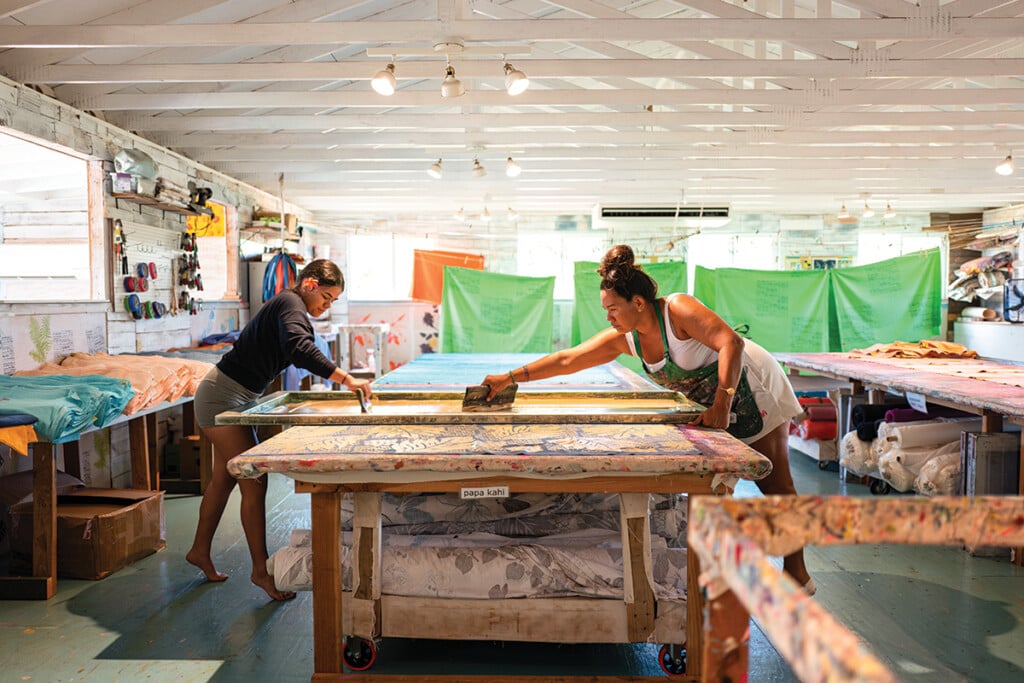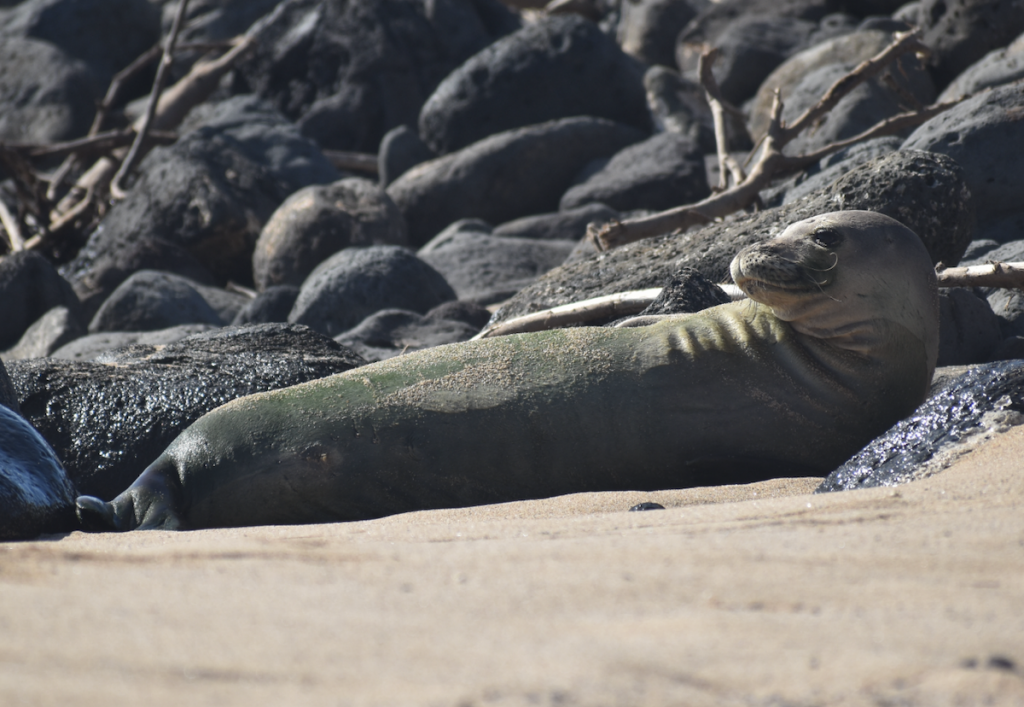Traveling to Molokaʻi is a Lesson in Slowing Down
Unlike any other island, the Friendly Isle is more than just a peaceful getaway.

During my most recent trip to Moloka‘i, I heard a common refrain: If you’re in a hurry, you’re on the wrong island. There are even signs along some roads that say, “Slow down this is Moloka‘i.”
Situated just 7.5 miles off Maui, Moloka‘i can seem a world away. It makes the easy-going Valley Isle feel like it runs at high speed. There isn’t even a stoplight here (but there are stop signs). I took all of this as a hint that it was time to pump the brakes for a few days.

This sign outside Molokaʻi Airport sums it up.
Photo: David Croxford
Moloka‘i attracts a specific type of traveler. A few Neighbor Island and out-of-state visitors who seek solitude and Hawai‘i’s rugged terrain might find themselves here. But not many people visit—and that’s how the residents want it. They’re less open to visitors than the folks on other islands, especially vacationers who view Hawai‘i only as a tropical resort destination. Rather, residents here expect travelers to engage with the community and respect the culture.
There isn’t anything about Moloka‘i that’s pretentious or glitzy. There’s only one hotel on the island and, thanks to Kanemitsu’s Bakery, Ala Mālama Avenue in Kaunakakai is the busiest street. And because everyone knows everyone on the island of about 7,000 residents, outsiders are easy to spot.
I visited the island twice while growing up on Maui, but memories of those times are hazy. I hopped on a ferry that departed early in the morning from bustling Lahaina and arrived two hours later in quiet Kaunakakai, the island’s main town. Before the sun disappeared, I boarded the return ferry to Maui, traversing rough seas that sent waves crashing onto the deck. I still remember the thrill of being soaked by ocean spray. But those are the clearest details I can recall. And the ferry is now a relic of the past. It stopped service in 2016.
This trip, I’m flying on Mokulele Airlines’ tiny nine-passenger plane. It’s only a 20-minute flight and like on the ferry rides, I’m sitting among Moloka‘i residents who make frequent trips to Maui, usually for provisions or business.
In the small Cessna aircraft, we fly past Moloka‘i’s emerald sea cliffs. Towering 3,000 feet above sea level, the island’s eastern bluffs are among the tallest sea cliffs in the world. With sharp ridges and cascading waterfalls, the views rival the famed Nāpali Coast on Kaua‘i. As we move inland, specks of houses appear over expansive stretches of rural land.
View this post on Instagram
From the airport, Hotel Moloka‘i is about a 15-minute drive away. Charming bungalows are spread across the beachfront property and fragrant plumeria trees adorn the grounds, along with mango, banana and ‘ulu (breadfruit) trees. Beneath the fruit trees, chickens and their fuzzy chicks roam as guests, too. My room is just steps from the beach and most mornings I observe the stillness of the ocean from my lānai (veranda). In the evenings, I dine at Hiro’s ‘Ohana Grill at the hotel, where live music wafts through the open-air restaurant and the tables are filled with guests and local families.
Michael Drew has been the general manager at the hotel for 15 years. The position brought him to the island, and he says there have hardly been any changes since he settled here. However, he did succeed at getting a crosswalk placed between the hotel and the neighborhood where he lives across the street.
Moloka‘i is often described as “old-school Hawai‘i.” There are no big-box retailers or chain restaurants, and there likely won’t ever be. Instead, homesteaders farm and grow food for their families and trade with neighbors. As an outsider, it’s inspiring to see a tenacious community with deep roots in the land. Each day, I learn from the island and its residents.

02: Moloka‘i is often described as “old-school Hawai‘i.” There isn’t even a stoplight on the island.
Photo: PF Bentley
It’s just before sunrise on my first morning in Moloka‘i and I’m gazing out at Kaunakakai Harbor with a few friends. Although sleepy, we’re all in awe of the glassy water colored by the rosy pink and soft blue sky. A lone stand-up paddler glides by, sending ripples across the way.
At dawn, we meet Capt. Clayton Ching. He runs Hallelujah Hou Fishing for both experienced anglers and novices. With Moloka‘i’s expansive sea flats, he specializes in fly fishing for large bonefish. The catch-and-release charters provide a sustainable excursion through Moloka‘i’s unique marine ecosystems.
But this fishing tour doesn’t require a boat. Wearing galoshes, I wade through water just above my knee, with Ching at my side. With every step, my boots sink into the sand. As I focus on staying upright, Ching reminds me to move gently, otherwise I’ll scare away the fish.
With more than 50 years of experience fishing, Ching’s eyes are well trained to spot the silver dorsal fins of bonefish, or ‘ō‘io in Hawaiian. After every few steps, he asks, “Do you see that?” No, but I don’t doubt that he does. We cast a rod and nothing bites.

With Moloka‘i’s expansive sea flats, Hallelujah Hou Fishing specializes in fly fishing for large bonefish.
Photo: Courtesy of the Hawai‘i Tourism Authority (HTA)/PF Bentley
Fishing is a hobby that requires great patience. “It’s a spiritual experience,” Ching explains. We’ve trekked 50 feet offshore; I’m supposed to be searching for bonefish, I pause to take in the unique views of Moloka‘i’s low mountains and Maui in the distance. Enamored by the scene and the stillness, I start to understand what lures people here.
But as the early hours of the morning fade and the wind stirs, it becomes more difficult to spot fish fins above the wind-blown surface. As we slowly make our way back to shore, Ching reminds me, “It’s not over until you leave the water. You never know what you’re going to spot at the very last moment.”
Although we don’t catch a single fish, not even in that last moment, I learn a lesson in patience and persistence. And I experience the beauty of moving slowly and soaking in the sensations.
After fly fishing—or any activity—a trip to Kanemitsu’s Bakery & Coffee Shop is in order. The family-owned bakery opened nearly 90 years ago and has been the heart of Kaunakakai for almost 80 years. It’s a landmark establishment and, with its bright green exterior, it’s impossible to miss.

At night, customers make their way to a back alley to order Kanemitsu’s soft, pillowy hot bread.
Photo: David Croxford
Inside the cozy restaurant, booths are filled with regulars dining over kimchi fried rice and loco mocos. Taro pancakes and French toast are served hot off the griddle. By lunch, all that’s left in the display case are a few rows of butter rolls and turnovers.
But Kanemitsu’s is famous throughout the Islands for its soft, pillowy hot bread. During the late hours of the night, customers make their way to a back alley to order loaves slathered with jelly, cream cheese or butter—or all three. It’s become a beloved tradition that spans generations.
At Kanemitsu’s I witness the routines of faithful customers, loyal to their specific tables and breakfast orders. The kitchen turns out plate after plate. Some arrive at tables quickly, others come later. But it isn’t a concern because there isn’t anywhere else to be. All that matters is sharing a satisfying meal in the company of friends.
Moloka‘i makes me relish moving slower, having no pressing plans. More than once I’ve found myself floating for hours in the pristine waters at Pāpōhaku Beach. In those times, aside from my friends, there was no one in sight on the 3-mile-long beach. One evening we drifted in the ocean for so long, we watched the sun set in the west and a nearly full moon rise in the east. I was immersed in the peaceful, healing ocean.

Pāpōhaku Beach on Molokaʻi.
Photo: Getty Images
During one of my last days on Moloka‘i, I made a short but important walk to the Kalaupapa overlook at Pālā‘au State Park.
When Hansen’s disease became pervasive in the Hawaiian Islands in the 1860s, the afflicted were exiled to isolation at the Kalaupapa peninsula on the north shore of Moloka‘i. The huge sea cliffs that leave many people in awe are the same ones that seclude Kalaupapa from the rest of the island.
Although some records have been lost, surviving documents show that starting in the 1860s at least 8,000 people, mostly Native Hawaiians, were forcibly removed from their homes and relocated to Kalaupapa to essentially await their deaths. It was chilling to see a place marked by trauma and the heartbreak of abandonment.
But during this period of incomprehensible suffering, a resilient community arose. Churches were built and became popular gathering places for dances and musical performances. Patients fell in love and married. Families were formed among patients, caregivers and clergy people.
Although the peninsula was once a kind of prison, it’s now a haven for the few remaining residents who have been cured of Hansen’s disease but still live with the trauma of having been exiled. Through local restoration and conservation efforts, many families have been able to trace a great-grandparent or relative to Kalaupapa and finally pay their respects to them. In 1980, the National Park Service designated Kalaupapa as a National Historical Park.

The Kalaupapa peninsula is a point of reflection and reminder of the human thread that connects us all.
Photo: PF Bentley
Access to the Kalaupapa trail and the small town is currently restricted, but the area remains an indispensable point of education and reflection. The peninsula is a reminder of the suffering and debilitating loneliness that resulted from Hansen’s disease, and of the beautiful community that forged together during a time of abandonment.
Looking at this small town separated from the world might make every traveler to the lookout reevaluate how people with differences are treated—and remember the human thread that connects us all.
I went to Moloka‘i with the intention of slowing down for a few days but left with a new perspective. The island taught me to appreciate stillness and savor moments of silence. I experienced the healing nature of the island but most importantly, I witnessed the remarkable bonds of an incredible community.
This story was originally published in the Fall 2022 issue of HAWAIʻI Magazine. Get the issue here.



